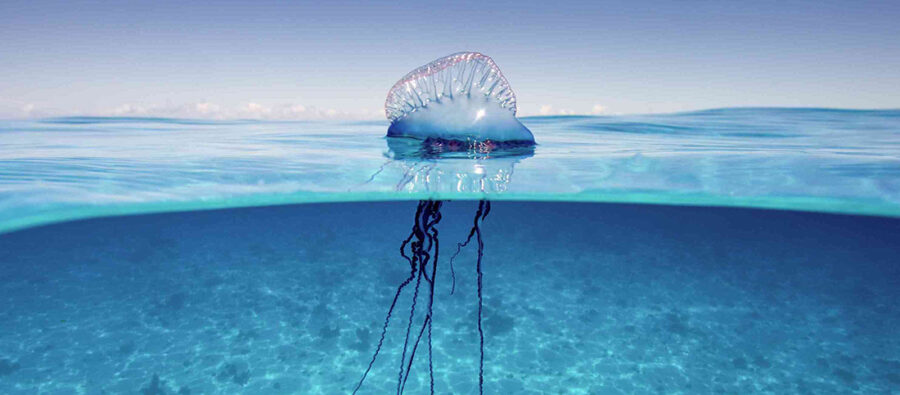
Despite how it looks, the Portuguese man o’ war is not a true jellyfish but rather a siphonophore, which is not actually a single organism (true jellyfish are a single organism), but a colonial creature made up of 4 specialized animals of the same species, called zooids (polyps). These polyps are attached to one another and physiologically integrated, to the extent that they cannot survive independently, creating a symbiotic relationship, requiring each polyp to work together and function like an individual creature. This article is on special request from my daughter.
First the Stats…
Scientific name: Physalia physalis
Length: Up to 165 feet
Lifespan: Unknown
Now on to the Facts!
1.) The name “man o’ war” comes from the 18th century European sailing warship, and their resemblance to the Portuguese ships at full sail.
2.) These dactylozooids are covered in venom-filled nematocysts, which is how the man o’ war kills their prey, typically that of small fish, crustaceans, and plankton.
3.) Stings usually cause severe pain, leaving whip-like red welts on the skin that typically last 2 – 3 days after the sting; though the pain usually fades after about 1 – 3 hours.
4.) In some instances, stings can result in swelling of the larynx – causing airway blockage & an inability to breathe, cardiac distress, fever, shock and, in extreme cases, even death can occur.
5.) Their main predators are ocean sunfish and loggerhead turtles. Another interesting creature, the blanket octopus, will use their tentacles as a defensive weapon by either tearing off a man o’ war’s tentacles or finding free floating tentacles and attaching them to their suckers.
But wait, there’s more on the Portuguese man o’ war!
6.) Another predator of this creature is the blue sea dragon. This nudibrach not only eats the man o’ war, but they also use the stinging toxins as a self defense mechanism.
7.) The man-of-war has no ability to propel itself, so it simply drifts aimlessly, either riding ocean currents or sailing as its pneumatophores catch the ocean breeze.
Did you know…?
You can use vinegar to wash away any remaining nematocysts, after the tentacles are removed, and then you soak the affected area in water that is at least 113° F for around 45 minutes.
8.) If there is danger on the water’s surface, they are able to temporarily deflate their pneumatophore (air sac) to submerge.
9.) Because of how they travel about, they tend to wash up on shores all over the world, as they are slaves to the currents.
10.) Their diet consists of small fish, shrimp, and other crustaceans.
But wait, there’s still more on the Portuguese man o’ war!
11.) The Portuguese man o’ war fish lives in the siphonophore’s tentacles. However, it is not immune to its stings. This fish lives off of the plankton that ends up in and around the man o’ war and also, on occasions, steals it’s host’s meals.
12.) Man o’ war gonozooids have special sacs that house ovaries or testes. So each colony can be considered as “male” and/or “female.”
13.) It is presumed that gonozooids release eggs & sperm into the open ocean water, which then become fertilized when they meet up with floating eggs or sperm from other man o’ war colonies.
14.) The man o’ war isn’t always alone. Large groups of over 1,000 colonies have been observed together. Imagine being the unlucky swimmer to get stuck in the middle of that bundle of joy! Holy schnikes, that would leave a mark!
Now a Short Portuguese Man O’ War Video!
Also, check out the Critter Science YouTube channel. Videos added frequently!
Want to suggest a critter for me to write about? Let me know here.



